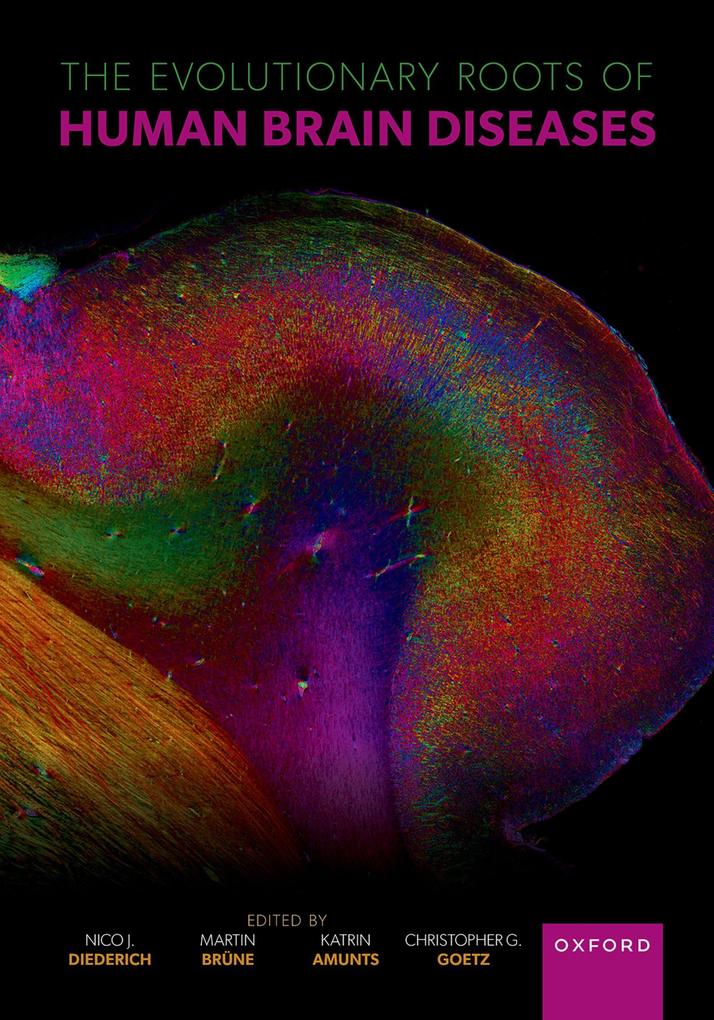
Zustellung: Mi, 25.06. - Mo, 30.06.
Versand in 2 Wochen
VersandkostenfreiBestellen & in Filiale abholen:
The Evolutionary Roots of Human Brain Diseases assembles recent findings in clinical neuroscience, evolutionary biology, anthropology, and cellular biology to elucidate the origins of human brain diseases and how evolution has given rise to exclusive impacts on brain health only in humans. The book is succinct, up-to-date, and written by researchers across numerous disciplines, making it a compulsory read for clinical neurologists, psychologists, and all medical researchers interested in the brain.
Inhaltsverzeichnis
- Foreword by Sten Grillner
- Introduction by the Editors, Nico J. Diederich, Martin Brü ne, Katrin Amunts, Christopher G. Goetz
- Part I: Human Brain Evolution: From Anatomy to Function
- Chapter 1: Human Telencephalization
- Katrin Amunts and Felix Strö ckens
- Chapter 2: Evolutionary Aspects of Glial Expansion
- Pierre Magistretti, Patrick Hof , Corrado Cali, and Nicole Ackermans
- Chapter 3: The Contribution of Mitochondrial Evolution and Dysfunction to Neurodegeneration
- Anne Grü newald, Sandro Pereira, and Kobi Wasner
- Chapter 4: Intrinsic Templates for Neurodegenerations Featuring Disease-specific Axonal or Dendritic Vulnerability
- Toshiki Uchihara
- Chapter 5: Differences in Brain Gene Expression Between Humans and Primates
- Geneviè ve Konopka and Emre Caglayan
- Chapter 6: Adapative Archaic Introgression
- Olga Dolgova and Oscar Lao
- Chapter 7: Goal-directed and Habitual Behaviors: Anatomical and Functional Circuits in Health and Neurological Disease
- Ledia F. Hernandez and Ignacio Obeso
- Part II: How Human Brain Diseases Are Impacted By Human Evolution
- Chapter 8: Alzheimer's Disease, the Parietal Lobes, and the Evolution of the Human Genus
- Emiliano Bruner and Heidi I. L. Jacobs
- Chapter 9: Parkinson's Disease - Overstrain Focused of Basal Ganglia and Brainstem Nuclei
- Nico J. Diederich and Christopher G. Goetz
- Chapter 10: Brain Diseases Associated with Unstable Repeats
- Peng Jin, Katharine Shelly, and Emily G. Allen
- Chapter 11: The Properties of Cortico-Motoneuronal Connections and Their Evolutionary Significance for Amyotrophic Lateral Sclerosis
- Roger Lemon
- Chapter 12: REM Sleep Behavior Disorder - Nocturnal Replay of a "Fight and Flee"
- Nico Diederich and Isabelle Arnulf
- Chapter 13: Mood Disorders: An Evolutionary Psycho-Neuro-Immunological Approach
- Markus J Rantala Javier I. Borrá z-Leó n
- Chapter 14: Schizophrenia - Embracing the Spectrum
- John S. Allen
- Chapter 15: Williams Syndrome and Autism - Dysfunction of Frontal Networks
- Katerina Semendeferi and Isabel August
- Chapter 16: ADHD - An Evolutionary View
- Annie Swanepoel
- Chapter 17: Addiction - Diverted Reward and Motivation Principles
- Roger Sullivan and Edward Hagen
- Part 3: Consequences and perspectives on research and clinical sciences
- Chapter 18: Conditions of Comparative Brain Connectomics
- Kathleen Rockland, Daniel Zachlod, and Katrin Amunts
- Chapter 19: Are Evolutionary Concepts Helfpul in Designing Preventive Strategies for Brain Diseases?
- Gilberto Levy and Bruce Levin
- Chapter 20: Evolutionary Aspects of Neuro-Psychopharmocology
- Martin Brü ne, Riadh Abed, and Paul St. John-Smith
- Chapter 21: Ongoing Human Evolution?
- Frank Rü hli, Maciej Henneberg, and Nicole Bender
- Chapter 22: Human Cultural Evolution Outpaces Biological Evolution: A Brain Connectomic Approach
- Jean-Pierre Changeux
- Chapter 23: Concluding Remarks and Future Directions
- Martin Brü ne, Katrin Amunts, Nico J. Diederich, and Christopher G. Goetz
Produktdetails
Erscheinungsdatum
26. Juli 2024
Sprache
englisch
Seitenanzahl
576
Herausgegeben von
Nico J Diederich, Martin Brüne, Katrin Amunts, Christopher G Goetz
Verlag/Hersteller
Produktart
gebunden
Gewicht
1379 g
Größe (L/B/H)
256/185/29 mm
ISBN
9780197676592
Entdecken Sie mehr
Bewertungen
0 Bewertungen
Es wurden noch keine Bewertungen abgegeben. Schreiben Sie die erste Bewertung zu "The Evolutionary Roots of Human Brain Diseases" und helfen Sie damit anderen bei der Kaufentscheidung.









